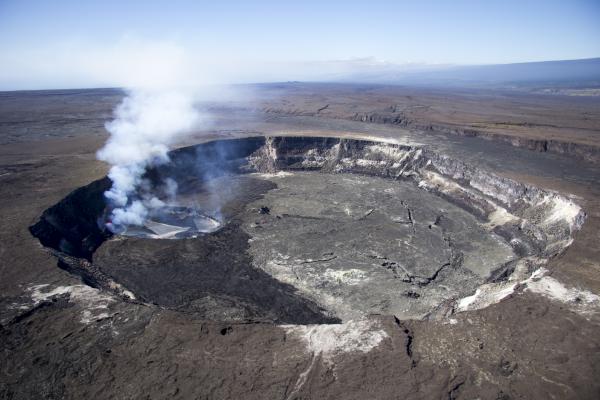Excellent retrospective the USGS put out in 2017 on the then nine-year-old lava lake at Kilauea’s summit, with great information and spectacular views:
USGS video description:
In March 2008, a new volcanic vent opened within Halema‘uma‘u, a crater at the summit of Kīlauea Volcano in Hawaiʻi Volcanoes National Park on the Island of Hawaiʻi. This new vent is one of two ongoing eruptions on the volcano. The other is on Kīlauea’s East Rift Zone, where vents have been erupting nearly nonstop since 1983. The duration of these simultaneous summit and rift zone eruptions on Kīlauea is unmatched in at least 200 years.
Since 2008, Kīlauea’s summit eruption has consisted of continuous degassing, occasional explosive events, and an active, circulating lava lake. Because of ongoing volcanic hazards associated with the summit vent, including the emission of high levels of sulfur dioxide gas and fragments of hot lava and rock explosively hurled onto the crater rim, the area around Halemaʻumaʻu remains closed to the public as of 2017.
Through historical photos of past Halemaʻumaʻu eruptions and stunning 4K imagery of the current eruption, this 24-minute program tells the story of Kīlauea Volcano’s summit lava lake—now one of the two largest lava lakes in the world. It begins with a Hawaiian chant that expresses traditional observations of a bubbling lava lake and reflects the connections between science and culture that continue on Kīlauea today.
The video briefly recounts the eruptive history of Halemaʻumaʻu and describes the formation and continued growth of the current summit vent and lava lake. It features USGS Hawaiian Volcano Observatory scientists sharing their insights on the summit eruption—how they monitor the lava lake, how and why the lake level rises and falls, why explosive events occur, the connection between Kīlauea’s ongoing summit and East Rift Zone eruptions, and the impacts of the summit eruption on the Island of Hawaiʻi and beyond.
Additional Credits:
Producers: Janet Babb and Steve Wessells
Writers: Janet Babb, Donna Matrazzo, and Steve Wessells
Director of Photography: Richard Lyons”
Before and After at Halema’uma’u
Prior to the lava lake, Kilauea’s summit contained the larger caldera, several miles across, within which was Halema’ua’u Crater, the volcano’s primary vent whose activity has been chronicled for a few hundred years. Prior to 1924, it was a lava lake, but 1924 explosive events drained it. During the 20th century it was gradually filled in by intermittent lava flows.

In 2008, a vent formed at the base of the wall of Halema’uma’u Crater, on the same side as the Halema’uma’u Crater overlook and parking lot (which was then closed to visitors for safety). Explosive events enlarged it into a lava lake.


[Backdated post written June 18, 2018. I’m trying to keep this blog as a chronological account of the current eruption, so I adjust posts’ timestamps to match content.]